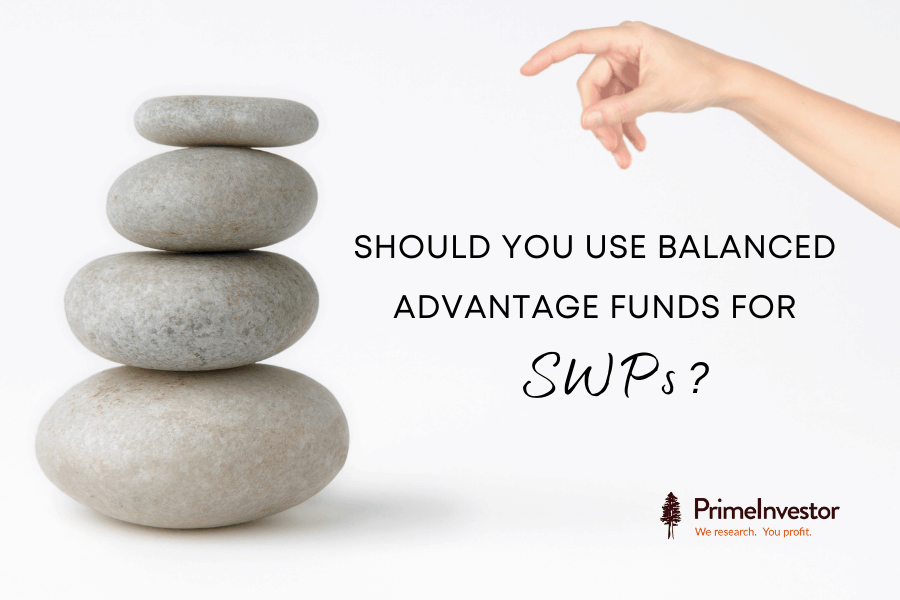Last week saw the NFO of SBI Balanced Advantage Fund close – and collect a whopping Rs 14,500 crore. That puts it in third place, in terms of size, in the balanced advantage/dynamic asset allocation category. A lot of the attraction here for investors, seeded by the distributors and the fund itself, centered around the scheme’s ability to offer monthly income.

This monthly income is from the fund’s SWP(A) facility, where you withdraw an amount set by the fund. This withdrawal rate was 6% annually, or 0.5% monthly, of your investment. Of course, you could select your own amount, too.
Yes, it’s a simple SWP. Yes, a 6% withdrawal rate is reasonable. Yes, a balanced advantage fund will reduce equity exposure when markets are expensive and use derivatives to reduce equity risk. Yes, a balanced advantage fund will deliver more than a debt fund, especially at these times.
But are these reasons enough to run SWPs from a balanced advantage fund? Please note that we’re including dynamic asset allocation funds as well when we refer to the category.
The balanced advantage background
To get there, let’s consider why the question even comes up now. Why have balanced advantage funds become so promising that they can apparently be used as an option to participate in equity in long-term portfolios, to give debt-plus returns in short-term portfolios, or to supply monthly cash flows through SWPs?
The answer lies in the way balanced advantage funds are structured. Their equity-derivative-debt combination is such that the narrative around the funds can be modified to appeal to investors no matter what the market scenario is. Consider the current equity market. With the Sensex and Nifty 50 frequently setting new highs even as the economy and corporate earnings are yet to show concrete signs of sustained recovery, it is natural to worry about entering at highs. But then you also worry about missing the rally. A balanced advantage fund (theoretically) reduces equity and ups derivatives when markets are expensive which cushions the impact of a correction. So, you get equity participation but escape equity risks.
Now take debt returns. Low interest rates and yields have kept liquid fund and other short-term fund returns and bank FD rates suppressed, while the duration strategy has lost steam. For those looking for low-risk options that can yet deliver better, balanced advantage funds seem to fit the bill. A balanced advantage fund can deliver higher than debt because its equity exposure helps. Thus, balanced advantage funds are seemingly perfect fits no matter your investment purpose.
Now before discussing if this is really the case, let’s remind you that the MF industry, like all other industries, plays to your sentiment. If a market bubble, not missing out on a rally, having better-than-FD income are your current worries then the industry markets its products as solutions to those problems.Whether the product is amenable to be tailored as a solution for your problem is a point that is often missed by the industry and investors.
In 2015-2017, for example, the dividend option of aggressive hybrid funds (then called balanced funds) and the ability of these funds to deliver better than pure equity was much hyped and eagerly lapped up. At the time, these funds were delivering more than large-cap funds. They were paying out steady dividends and were marketed as ‘income products’ – stating that the debt component will ensure steady income even if equity falls.
The risks involved in these funds – which is that they were not impervious to market falls, that part of the returns came from mid-and-smallcap exposure – were brushed aside.
The fallout, of course, was in 2018 and 2019, when balanced funds lost returns. The monthly dividend options were quietly withdrawn. The performance dip sustained until the current broader market recovery that began in mid-2020. Aggressive hybrid funds quickly lost their charm. A similar story plays out in the then-MIPs or monthly income plans (today’s conservative hybrid funds). These funds have since turned uneven performers, have varying debt strategies that make it hard to understand what the risk or volatility involved can be, and have been hurt in equity corrections as well. You can read our view on this category here.
Today, it appears to be the turn of balanced advantage funds. Even ignoring the SBI fund’s record collection, we have had many queries from you on whether you should invest in balanced advantage funds and/or use these for SWPs.
What is needed for SWP
We’ve covered SWPs in detail in a different article. Among the points we covered in that article was the nature of funds to go for. To run an SWP from a fund, two aspects are important:
- One, the fund needs to be low volatile. A high volatile fund will see losses or low returns. SWPs could therefore result in withdrawing from your capital or when returns are poor.
- Two, the fund should not see prolonged periods of low returns. should this happen, it would mean the fund is not generating the returns needed to keep your capital intact.
Therefore, funds picked for SWPs should be those where downsides are limited or where pick-up is unlikely to take time even where there are such return dips. Now, consider balanced advantage funds in this light.
We have explained where balanced advantage funds invest in detail and explained whether you should invest in balanced advantage funds in two earlier articles. Here, we’ll emphasize some details explained in these two articles to answer the two points above.
#1 Low volatility
Balanced advantage funds are not low volatile. The deviation in 1-month returns for these funds is three times higher than short-term debt funds. Balanced advantage funds also do not have limited downsides. On an average, these funds delivered 1-month losses about 24% of the time considering the past 5 years. In contrast, money market funds or even ultra-short duration funds delivered 1-month losses just 2% of the time. Liquid funds did not deliver losses at all.
Next, the worst 1-month loss that money market funds or ultra-short duration funds delivered was 1-2%. The worst 1-month loss that balanced advantage funds delivered was 18% on an average. If you take individual funds, some funds dropped even 20-30%. This was during the March-April 2020 period, when returns collapsed in equity markets.
Let’s take an example. Say you had invested Rs 10 lakh in balanced advantage funds in August 2018 and began a withdrawal of Rs 5,500 per month (roughly around 6% annual withdrawal) from September onwards. If you had invested in Invesco India Balanced Advantage, a more aggressive fund, you would be sitting on a fund value of Rs 10.29 lakh today. That’s not very different than if you had invested in a fund like Axis Treasury Advantage. That’s because you would have been withdrawing even when the fund was doing poorly without giving it the time to recover. In fact, Invesco India Balanced Advantage would have bounced back from losses to reach your original investment cost only in June 2021.
Even on a 1-year basis, balanced advantage funds averaged losses about 15% of the time in the past 4-year period. The average 1-year loss was 12%, though individual funds went as low as 16-20%.
Therefore, a balanced advantage fund can fall and fall sharply. It can fall frequently in the short term. When you run an SWP from balanced advantage funds, you also run the risk of redeeming at losses or redeeming when returns are very poor.
#2 Return and strategy differential
A balanced advantage fund’s performance comes from the extent it holds in equity and the extent to which it hedges this equity through derivatives. A higher unhedged equity means that upsides can be better but volatility and downsides will also be more. Funds decide the hedged exposure based on equity market conditions. Theoretically, when markets are expensive or uncertain, a fund needs to increase its hedging and reduce the exposure to unhedged equity. This will help cushion a market fall.
The reality is different. The table below shows the unhedged equity exposure for balanced advantage funds in the past 3 months. As you can see, each fund has a different opinion on how much to leave unhedged and whether to increase or reduce unhedged equity.
The difference comes because each fund uses different metrics to judge market levels. Even while these funds use models to determine allocations, a fund manager overriding these calls to chalk up higher returns is a secondary risk.
A high unhedged equity in a market fall does two things – one, it means steeper downsides and two, a longer time to reverse the fall. In 2020, the very swift and very sharp market recovery helped these funds bounce back quickly. That may not be true in any future market correction; a longer recovery or a more sedate one could mean suppressed returns from these funds for a longer period.
In such a case, running an SWP from these funds means that you have smaller gains to buffer up your withdrawal and prevent capital erosion. Banking on a fund to reduce equity exposure when markets are high is not foolproof. You do not control what the fund does and nor do you know what allocations the fund can take.
#3 Lack of history
The final point with balanced advantage funds is that there is a limited record of fund performance. The category in its current form came up only in 2018. Prior to this, these funds came from different categories or were the yesteryear balanced funds which took a bit of derivative exposure. How these funds perform across market cycles, how much they can contain downsides and capture market rallies, how their performance might pan out in cases of prolonged market corrections or a range bound market are all yet to be tested. This is unlike categories such as aggressive hybrid or conservative hybrid which have existed across the years.
What should you do?
Balanced advantage funds are lower risk than pure equity funds. They have the capacity to deliver returns better than pure debt funds. And therefore, it is possible to use them to generate some monthly cash flows. But you need to do this the right way.
As you now know, balanced advantage funds are volatile and can fall. So, you cannot invest in these funds and quickly start an SWP. You need to hold these funds for at least 1.5 to 2 years before you consider any withdrawal. This will ensure that any correction is absorbed, that you don’t inadvertently draw down from your capital and that the fund has the time to deliver the optimal returns.
For an SWP, always start with liquid funds. These are the best fits for immediate withdrawal because of their low risk, low volatile nature. Add on other categories such as ultra-short, low duration or money market funds. These funds should always form the bulk of your SWP portfolio; at the very least, the amount you invest in these funds should be enough to meet at least 4-5 years of your cash flow requirements.
The remaining portion of your portfolio can then be invested in other fund categories, including balanced advantage funds. When picking balanced advantage funds, it is important that you know how aggressive the fund is. Very sharp swings in the unhedged equity allocation or a very high unhedged equity means that the fund is higher-risk. This can either be avoided for your income-generating portfolio or you will need to give them a longer holding period (than the 2 years mentioned earlier) before withdrawing.
Give our earlier article on SWPs a read. Also refer to our article on post-retirement portfolios to understand if and what equity exposure you can take in an income-generating portfolio.
With so many fund houses and plethora of schemes, every fund house needs a selling point. If it was dividend income earlier, it is SWP now. Buyer beware holds good now more than ever.
P.S. If you want to start planning your SWP or know how long your savings will last, use this SWP Calculator to find out.
References : SBI Balanced Advantage Fund records highest ever NFO collection at Rs 14,500 crore







16 thoughts on “Should you use balanced advantage funds for SWPs?”
Thanks for this great article! For my mother I would like to generate regular monthly income. So my query is that is it possible to generate 1 lakh income through SWP from 2 crore investment at 5% withdrawal rate? If yes how should I proceed in terms of selection of funds categories? Thanks.
You’d need a slightly higher withdrawal rate of 6%, if you want to generate a monthly income of Rs 1 lakh. Either way, the withdrawal rate is fine. Please read this article to know which categories to go for: https://www.primeinvestor.in/swp-a-low-tax-option-to-generate-income/
– thanks, Bhavana
A very well written article. Cleared a lot of doubts. However one query is still nagging- You say that in case of planned SWP , minimum holding time should be 1.5-2 yrs. Does this means that, in case I intend to have SWP , say 3 years later, will I be better off shifting intended funds to balanced funds rather than debt fund?
No, we’re not saying shift to balanced funds. We’re saying that if you want to hold these funds in an SWP portfolio, it should be such that any withdrawal happens at least 2 years after you invest. Ideally, the first few years of expenses should be met through debt funds to truly let the equity portion work. – thanks, Bhavana
Your article require more exlaination.
In the last 4th column you mentiobed”Investor should not start SWP in these funds immediately but hold it for one half to two years This will ensure any correction to be absorbed”
As no one knows when correction will happen ,this two year holding require explanation.
Every fund has a minimum period for which you should hold, in order to allow any ups and downs to play out and prevent losses. For balanced advantage funds, this is around 2 years. These are not full equity funds. They hedge equity and they use debt. Therefore, once you hold past the minimum period, there is enough return built up that a fall will not result in losses or at least keep it very low. Only the very aggressive balanced advantage funds may see deeper losses – please see our other articles on balanced advantage funds to know the differences between funds. – thanks, Bhavana
If one starts 5 year SWP from balance advantage fund in current scenario with say 7% pa withdrawal rate; will that be bad choice? (Assuming that principle is NOT going to be needed for 5 years?)
Do you mean you will start the SWP after staying invested for 5 years, and you plan a 7% withdrawal rate? That’s fine. – Regards, Bhavana
No, I wanted your opinion in starting immediate SWP but with clear understanding that it will continue for 5 years (even if principal reduces in the interim). Based on past data for long running schemes; what is the probability that one would end with loss of original capital after 5 years?
The entire article is on why you shouldn’t do immediate SWP from balanced advantage funds 🙂 It’s your call, if you want to. We don’t have enough history on their performance to know 5-year return trends. – thanks, Bhavana
“the MF industry, like all other industries, plays to your sentiment” – there can be a whole article around this point! 🙂
Indeed 🙂 Thanks, Bhavana
Well presented. The MF industry is guilty of flogging a good idea beyond rational limits. And I guess it’s now become an ego tussle amongst the top AMCs to report ‘highest’ collections.
Further, one doesn’t know what was the ‘motivation’ of distributors to market a ‘flexicap’ here or a ‘BAF’ there !
Keep up the good work. You guys remain a sane voice amidst the din !
Thanks! – Regards, Bhavana
Can u pl suggest good fund, with return of 10% + plus capital safety, alternative to bank deposit. What is the advantage of SWP or dividend pay out, when there is no regular requirement of monthly income?
As the market in peak, even balanced funds are not safe. Your advice solicited
High returns does not come with capital protection. It’s very hard to get a steady 10% return with no risk, especially now when rates are low. Please read the article on SWP (https://www.primeinvestor.in/swp-a-low-tax-option-to-generate-income/) where the tax impact and how it works is explained. As far as dividend goes, there is absolutely no advantage. We’ve talked about dividends here: https://www.primeinvestor.in/no-ddt-the-impact-on-your-dividend-income/. – thanks, Bhavana
Comments are closed.